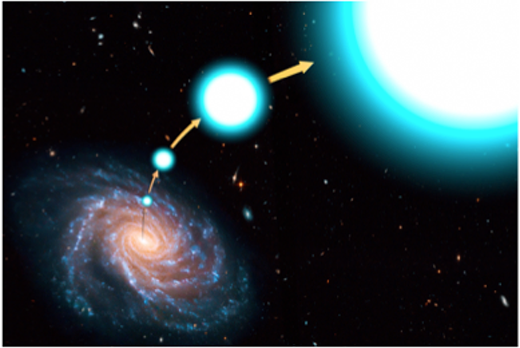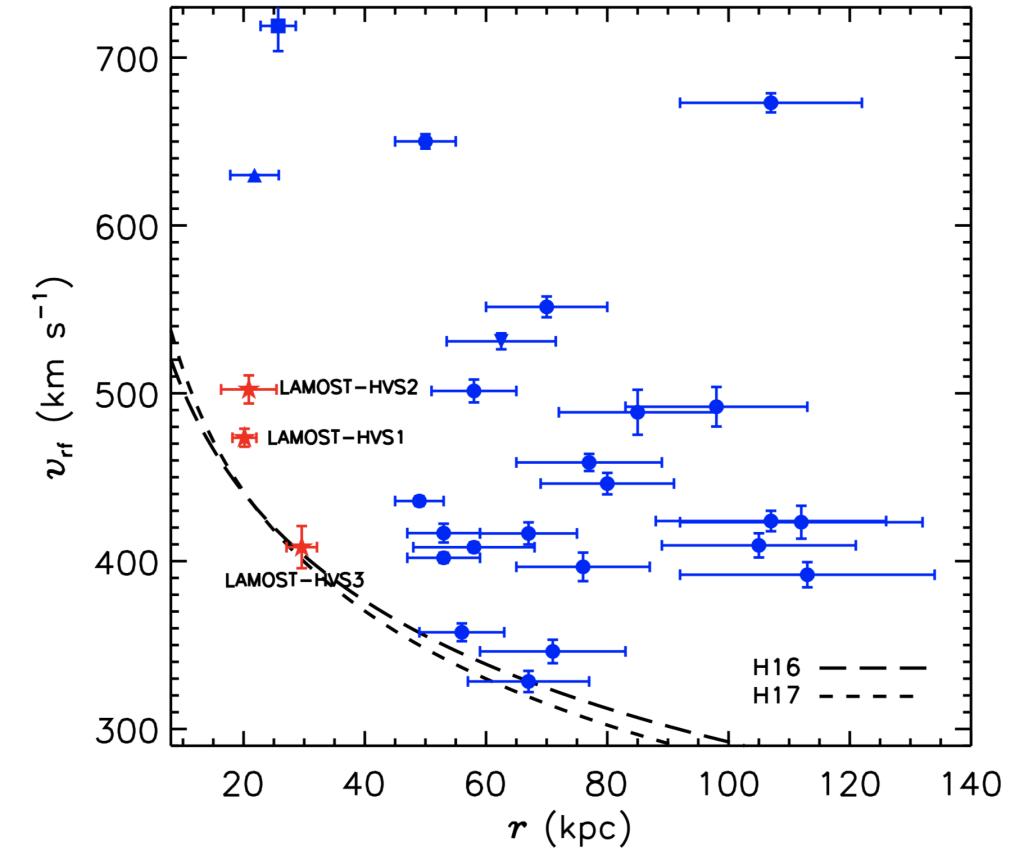中国西南天文研究所基于大科学装置LAMOST发现两颗超高速星
Discovery of two more runaway stars from the LAMOST Spectroscopic Surveys
近日,云南大学中国西南天文研究所刘晓为教授团组基于国家大科学装置郭守敬望远镜(大天区面积多目标光纤光谱天文望远镜,英文简称LAMOST)大规模银河系光谱巡天新近发现了两颗距地球7万多光年的超高速星,分别命名为LAMOST-HVS2和LAMOST-HVS3。这是基于LAMOST大规模银河系光谱巡天发现的第二和第三颗超高速星。
银河系中的大多数恒星都像太阳一样以约200 千米每秒的速度绕银河系中心运动。所谓超高速星是指一类速度高到能够脱离银河系引力束缚的恒星,如果寿命允许,它们将最终飞出银河系。20世纪80年代末,美国洛斯阿拉莫斯国家实验室天体物理学家杰克·希尔提出,运动到银河系中心超大质量黑洞附近的双星系统有可能被黑洞巨大的潮汐力所瓦解,被瓦解的双星系统的一颗自行被高速抛出,成为超高速星。该预言提出近20年之后,美国哈佛-史密森天体物理中心科学家沃伦·布朗才第一次在银河系中探测到此类恒星。探测超高速星极为困难,迄今为止,天文学家也仅仅在数千亿颗银河系恒星中证认出了20余颗此类恒星,远低于银河系有超过1000颗超高速星的理论预言。
此次由团组成员黄样博士牵头发现的两颗超高速星均是离银河系中心较近(100万光年以内)的明亮天体。其中LAMOST-HVS2与此前郑政等人基于LAMOST数据发现的首颗超高速星LAMOST-HVS1有着相近的银心距,是目前发现的距银心最近的超高速星。这非常有利于对它们进行更为细致的后续观测和研究。尤其是结合欧空局新一代天体测量卫星Gaia即将释放的高精度自行数据之后,将有望对超高速星的产生机制、银河系中心超大质量黑洞的性质以及银河系暗物质晕的质量分布给出极为严格的约束。
目前该研究成果已被国际专业学术期刊《天体物理学杂志通讯》(The Astrophysical Journal Letters)接受并得到审稿人高度评价。成果在预印本文库发布后(https://arxiv.org/abs/1708.08602),首颗超高速星的发现者沃伦·布朗教授第一时间发来贺信,称这是“令人兴奋的一对超高速星发现”(“an exciting pair of hypervelocity star discoveries”)!随后,今日宇宙(Universe Today)和世界科技研究新闻资讯网(Phys.org)等媒体分别撰文予以报道。
报道链接:
云南大学:http://www.ynu.edu.cn/info/1153/28106.htm
中国科学院国家天文台:http://www.bao.ac.cn/xwzx/kydt/201709/t20170912_4858622.html
国家自然科学基金委员会:http://www.nsfc.gov.cn/publish/portal0/tab448/info71350.htm
科技日报:http://scitech.people.com.cn/n1/2017/0914/c1007-29534495.html
Universe Today: https://www.universetoday.com/137100/chinese-astronomers-spot-two-new-hypervelocity-stars/
Phys.org: https://phys.org/news/2017-09-distant-hypervelocity-stars-chinese-astronomers.html
AAS NOVA: http://aasnova.org/2017/09/25/discovery-of-two-more-runaway-stars/


图1.超高速星逃逸出银河系想象图(左图,采自NASA);此次LAMOST发现的两颗超高速星LAMOST-HVS2和LAMOST-HVS3(右图)。
延伸阅读:
郭守敬望远镜(大天区面积多目标光纤光谱天文望远镜,英文简称LAMOST)是我国自主创新研制的具有国际竞争力的首台天文大科学装置,能同时获取最高4000个分布在20平方度视场里天体的全光学波段(370-900纳米)中低色散(R~1800)光谱。LAMOST的光谱获取率是当时国际同类最先进巡天望远镜SDSS的6.25倍。LAMOST的建成为我国开展银河系大规模光谱巡天,研究银河系的结构、形成和演化并在世界上占有一席之地提供了一个极为难得的、重要的历史机遇。在充分分析LAMOST实测性能指标及积累的观测数据的基础上,结合LAMOST所处兴隆观测站地理位置及天文气候条件,LAMOST科学委员会确立了以大规模银河系光谱巡天及多波段天体光谱证认为核心科学目标的巡天计划。该巡天计划包括三部分,其中由云南大学中国西南天文研究所刘晓为教授团组提议、设计并领导实施的LAMOST银河系反银心方向光谱巡天(LSS-GAC)是整个巡天计划的重要组成部分,取得了重要系列成果。LSS-GAC通过对银河系薄盘、厚盘、晕及其过渡区域各类恒星的系统分光观测,首次在国际上实现了银河系大规模光谱巡天在天区覆盖、巡天体积、采样密度及统计完备性等方面的重大突破,为开展银河系特别是银盘的系统研究提供了极好的、具有传承价值的样本。截至2016年12月31日,基于LAMOST数据发表的科学论文已超过200篇,引用次数近1200次。其中刘晓为教授担任首席科学家的国家重点基础研究发展计划(973计划)项目“基于LAMOST大科学装置的银河系研究及多波段天体证认”为LAMOST巡天计划的实施和科学研究作出了重要贡献。LAMOST巡天项目的实施,使我国在“基于‘郭守敬望远镜’(LAMOST)、‘日内瓦-哥本哈根巡天’(GCS)、‘斯隆数字巡天’(SDSS)等观测对星系结构、成分和演化的研究”这一国际前沿热点领域的研究处于与美国等西方发达国家“并跑”的位置(见冷伏海、赵庆峰、周秋菊《中美科研实力比较研究:基于〈2016研究前沿〉的分析》,《中国科学基金》2017年第1期)。

A study by the research group led by Prof. Xiaowei Liu (刘晓为) from the South-Western Institute for Astronomy Research (SWIFAR) at Yunnan University reports the discovery of two new unbound hypervelocity stars from the LAMOST spectroscopic surveys. The results were published in The Astrophysical Journal Letters (Huang et al. 2017, ApJL, 847, 9).
Hypervelocity stars (HVSs) are rare objects of extreme fast velocities allowing them to escape the Milky Way galaxy. One of the most commonly proposed scenarios is that they originate near the Galactic center (GC) by dynamical interactions between (binary) stars and the central massive black hole(s) (MBH). Alternative explanations exist, for examples, they could be the tidal debris of an accreted and disrupted dwarf galaxy, or they could be surviving companion stars of Type Ia supernovae.
In addition to exploring the origin of HVSs, scientists also care about these speedy objects since they are powerful tracers to probe the mass distribution of the Milky Way, given the fact that they travel large distances across the Galaxy.
For these reasons, scientists have been searching for HVSs, both systematically and serendipitously, for many years. However, only about 20 HVSs have been identified hitherto, much less than the number of over 2,000 predicted by the theory. Therefore, it is of vital importance to discover more new HVSs.
Our group has carried out a systematic search for HVSs amongst nearly 6.5 million high-quality stellar spectra of 4.4 unique stars collected up to June 2016 by the LAMOST spectroscopic surveys, and have discovered two new HVSs. They are respectively a B2V type star of about 7 Msun with a Galactic rest-frame radial velocity of 502 km s−1 at a Galactocentric radius of about 21 kpc, and a B7V type star of about 4 Msun with a Galactic rest-frame radial velocity of 408 km s−1 at a Galactocentric radius of about 30 kpc. The two stars are very bright and the upcoming Gaia data release should provide proper motion measurements accurate enough to give direct constraints on their origins.
We expect more HVSs will be discovered by the on-going LAMOST spectroscopic surveys, providing further constraints on the nature and ejection mechanisms of HVSs.
News Links:
Yunnan University: http://www.ynu.edu.cn/info/1153/28106.htm
NAOC: http://www.bao.ac.cn/xwzx/kydt/201709/t20170912_4858622.html
NSFC: http://www.nsfc.gov.cn/publish/portal0/tab448/info71350.htm
Science and Technology Daily: http://scitech.people.com.cn/n1/2017/0914/c1007-29534495.html
Universe Today: https://www.universetoday.com/137100/chinese-astronomers-spot-two-new-hypervelocity-stars/
Phys.org: https://phys.org/news/2017-09-distant-hypervelocity-stars-chinese-astronomers.html
AAS NOVA: http://aasnova.org/2017/09/25/discovery-of-two-more-runaway-stars/
